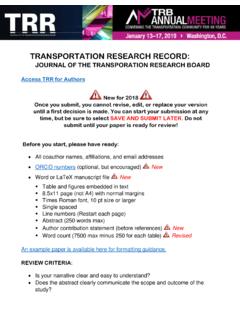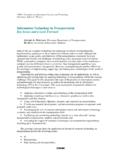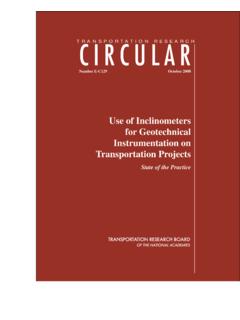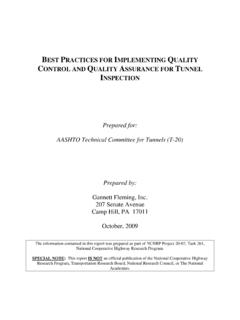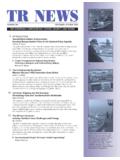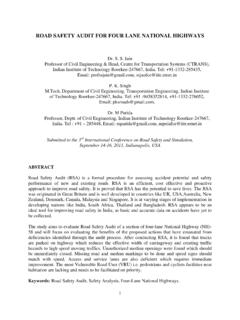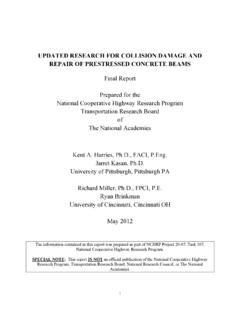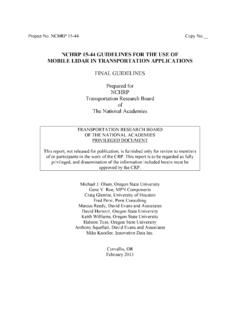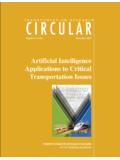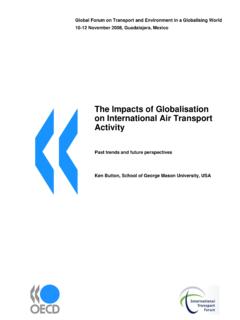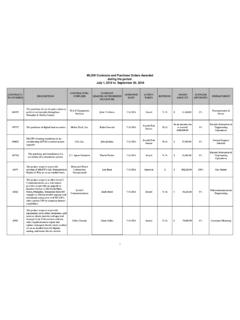Transcription of Bridge Maintenance and Management: A Look to …
1 A3C06: Committee on Structures Maintenance and ManagementChairman: Wallace T. McKeel, Maintenance and ManagementA Look to the FutureGEORGE HEARN, University of ColoradoRONALD L. PURVIS, Liechtenstein AssociatesPAUL THOMPSON, ConsultantWILLIAM H. BUSHMAN, Virginia Transportation Research CouncilKEVIN K. MCGHEE, Virginia Transportation Research CouncilWALLACE T. MCKEEL, JR., Virginia Transportation Research CouncilAs the third millennium dawns, the United States is in the midst of a Bridge crisis : Maintenance needs for older bridges have far outpaced available resources. This situationindicates the need not only for improved repair and rehabilitation techniques but also for acomprehensive approach to Bridge management. Fortunately, advances in the power ofmicroprocessors have made available personal computers and instrumentation that greatlyenhance the ability of Bridge engineers to manage and monitor structures, then take theproper action at the right time.
2 In this paper, we seek to define the current state of the art inbridge Maintenance and management and to look ahead to the challenges that this field willface in the 21st MANAGEMENT SYSTEMSB ridge owners today must make decisions pertaining to Maintenance and improvementsthat take into account both funding constraints and the overall needs of the highwaysystem. The states, the Federal Highway Administration, and the American Association ofState Highway and Transportation Officials have been working to develop and implementautomated decision-support models to assist Bridge managers. Bridge management systems(BMSs) represent a unique convergence of the disciplines of structural engineering,operations research, economics, planning, and information technology. The BMSsubcommittee, a focal point for research in this critical interdisciplinary area, has provideda forum for the exchange of experiential knowledge on BMSs among states throughTransportation Research Board paper presentations, publications, and specialtyconferences.
3 The subcommittee works in the following Collection MethodsEffective support of Bridge management decision making requires obtaining timely andquality data about Bridge conditions, project costs, and effectiveness. Because of theexpense of data collection, Bridge managers must exploit new technologies and processefficiencies to continually improve data quality while simultaneously controlling the costsof data collection. Further development and evaluation of improved visual inspectionprocedures, innovative nondestructive testing methods, and automated methods to gatherand manage data should be in the New Millennium2 Models of Bridge Deterioration and the Effect of Maintenance ActivityOne way in which BMSs assist decision makers is in forecasting the effect of agencyactions on the health and economic performance of the Bridge inventory. By studying thechanges observed in Bridge conditions over time, researchers can develop models todistinguish the effects of Maintenance activity from the normal processes of bridgedeterioration.
4 State-of-the-art work in this area includes deepening our understanding ofphysical deterioration processes, especially the effect of structural damage on the reliabilityand performance of structural of Bridge VulnerabilityBecause most Bridge failures in the United States result from unpredictable extreme events,such as earthquakes and floods, we must improve our understanding of the vulnerability ofbridges to such events. With this understanding, we will improve strategies to reduce therisk of Cost FactorsBMSs require the development of cost factors that are accurate enough to allow crediblebudgeting and program planning. BMS costing methods depend on an understanding of therelationships between the Bridge conditions, treatment selection, and the resources (such aslabor, materials, equipment, traffic control, and engineering) that are consumed incompleting treatment. Regarding the current state of the practice, costing methods and dataare suitable for network-level BMS models but not for project-level analysis.
5 Additionalresearch in this area could greatly improve the accuracy of project-level cost Economic Analysis of Project- and Network-Level TradeoffsCurrent research in this area focuses on improved optimization techniques that minimizethe life-cycle agency and social costs of a Bridge inventory and maximize the performanceof the inventory within limited resources. By making optimization models faster and moreflexible, the application of new computational techniques and paradigms can provide ameans of implementing the research results with more detailed and realistic data with Asset ManagementBridges are only one part of the infrastructure of a transportation agency. Increasingawareness that transportation assets are interdependent leads to the requirement that eachBMS fit with other agency systems in several ways, including database navigation,geographic referencing, sharing of software components and data collection resources, andthe development of common performance measures.
6 These cooperative efforts support anintegrated planning and programming process, which fosters enhanced communication andcoordination among engineers, planners, and managers to promote the agency s EVALUATION AND INSPECTIONIn the future, Bridge inspection will focus on the quantitative assessments of bridgeperformance and conditions rather than visual inspections and condition ratings. A varietyof permanent sensors on bridges will collect data at many points. These sensors will bepowered by and will report to wireless networks. Data will be analyzed anddeterioration will be detected automatically by computer workstations in central problems arise, engineers will be able to accurately analyze the structural conditionStructures Maintenance and Management3and formulate timely corrective strategies. Knowledgeable, experienced engineers are thekey to an accurate evaluation of the structural condition.
7 Technology will greatly enhancetheir ability to make these offer definite, unbiased, and quantitative data. These data enable engineers touse high-performance concrete and steel materials along with fiber-reinforced compositematerials to increase the service life of bridges. Extensive use of sensors will becomepossible as advances in the miniaturization of electronic devices, increased availability ofwireless communications, and lower costs for devices and communication combine toprovide an array of compact, permanent, inexpensive of Bridge performance will include the detection of changes in chemicaland electrical properties of materials related to deterioration, aging in coatings, andchanges in service environment or exposure; in addition, the response to loads will beverified periodically. Systems for measuring Bridge performance may include Embedded sensors for measurement of corrosion potential and current, Load cells permanently built into Bridge bearings to allow periodic verification ofload paths, Interferometry for surface flatness to detect aging in coatings and damage in fiber-reinforced composite elements, Embedded fiber-optic sensors for crack detection and strain measurement, Permanent features in substructures for rapid mounting of laser systems fordeflection measurements (permanent, dedicated mounting locations allow simplecollection and comparison of response signatures)
8 , and Radar and infrared sensors housed in overhead Bridge lighting and interrogatedwhen weather conditions are new inspection technologies will detect and measure deterioration in bridges,inspectors will have extensive quantitative data about the condition and performance ofstructures. Armed with this information, Bridge engineers will be able to make betterdecisions about repairs, to redesign details that will improve durability, and to usespecialized repair new inspection practices outlined here can be implemented. The sensors and datacommunication hardware exist. Hardware is costly today, and the long-term durability ofsensors has not been established. However, these limitations will be overcome throughresearch, development, and systems must be further developed to analyze data. Systems mustinclude data interpretation, statistical analysis, evaluation of errors in measurement,identification of Bridge conditions based on data, and assessment of structural reliability inits present condition.
9 Recent work in system identification and sensitivity of systemresponse to damage are relevant here. Overarching systems for data analysis and reportingare Maintenance , REPAIR, AND REHABILITATIONThe repair of bridges often has been a reactive activity, initiated only when deteriorationthreatens the safety or tolerance of the public. Now, influenced by BMSs, owners arebeginning to emphasize cost-effective proactive strategies from the start, when the bridgeis new. One future focus will be preventive Maintenance . Agencies that take the lead in thisTransportation in the New Millennium4area are reaping dividends in service life through activities such as cleaning bridgecomponents, overlaying decks, maintaining the integrity of joint seals, and MembersConcrete members are subject to spalling due to corrosion of the underlying reinforcement;scaling caused by freezing and thawing; and cracking caused by shrinkage, flexure, ordifferential settlement.
10 Advanced materials such as polymers and high-performancehydraulic cement concretes show promise for making repairs. Various kinds ofnoncorroding reinforcement that are under evaluation may eliminate spalling and thusreduce the need for spalling is caused by corrosion of the reinforcement, which is brought on bychloride contamination, a permanent repair must halt the corrosion process. Cathodicprotection effective, but seldom used to date is one alternative. Research on chlorideion removal from the concrete also looks promising. Improved instrumentation fordetecting corrosion and controlling the cathodic protection process will expand thepopularity of these techniques. Protective coatings and overlays applied in a timely mannercan slow salt penetration and delay the initiation of deck corrosion. The emphasis in theseapplications (both now and in the future) is on rapid repairs, often performed at night tominimize user costs.
